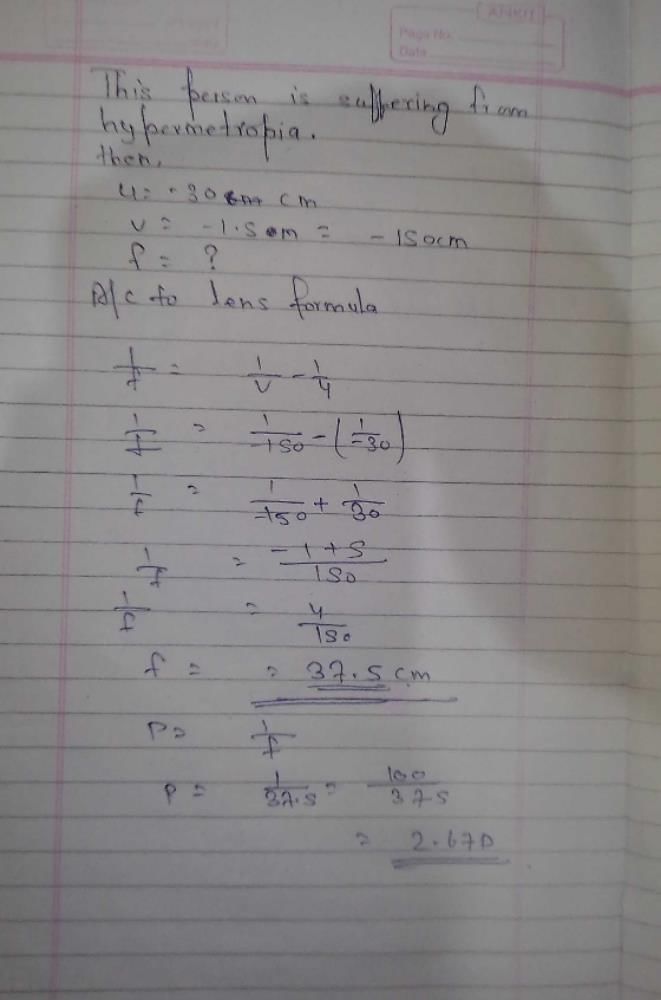Class 10 Exam > Class 10 Questions > A person with defective eyesight is unable to...
Start Learning for Free
A person with defective eyesight is unable to see objects clearly nearer than 1.5 m. He wants to read a book placed at a distance of 30 cm from his eyes. The type of a required lens and its focal length is
- a)Concave lens, f = 37.5 cm
- b)Convex lens, f = 30.5 cm
- c)Convex lens, f = 37.5 cm
- d)Concave lens, f = 30.5 cm
Correct answer is option 'C'. Can you explain this answer?
Most Upvoted Answer
A person with defective eyesight is unable to see objects clearly near...
This person suffers from the defect of hypermetropia.
For him u = -30cm, v = -1.5 m = -150cm
Therefore, focal length of corrective lens to be used by him is
1/f = 1/v- 1/u = 1/-150 - 1/-30 = 4/150 = 37.5cm
The positive sign shows that the lens needed is a convex lens of focal length 37.5 cm.
Hence, power of lens needed
P =1/f = 100/37.5 = 2.67D
Free Test
FREE
| Start Free Test |
Community Answer
A person with defective eyesight is unable to see objects clearly near...


|
Explore Courses for Class 10 exam
|

|
Question Description
A person with defective eyesight is unable to see objects clearly nearer than 1.5 m. He wants to read a book placed at a distance of 30 cm from his eyes. The type of a required lens and its focal length isa)Concave lens, f = 37.5 cmb)Convex lens, f = 30.5 cmc)Convex lens, f = 37.5 cmd)Concave lens, f = 30.5 cmCorrect answer is option 'C'. Can you explain this answer? for Class 10 2025 is part of Class 10 preparation. The Question and answers have been prepared according to the Class 10 exam syllabus. Information about A person with defective eyesight is unable to see objects clearly nearer than 1.5 m. He wants to read a book placed at a distance of 30 cm from his eyes. The type of a required lens and its focal length isa)Concave lens, f = 37.5 cmb)Convex lens, f = 30.5 cmc)Convex lens, f = 37.5 cmd)Concave lens, f = 30.5 cmCorrect answer is option 'C'. Can you explain this answer? covers all topics & solutions for Class 10 2025 Exam. Find important definitions, questions, meanings, examples, exercises and tests below for A person with defective eyesight is unable to see objects clearly nearer than 1.5 m. He wants to read a book placed at a distance of 30 cm from his eyes. The type of a required lens and its focal length isa)Concave lens, f = 37.5 cmb)Convex lens, f = 30.5 cmc)Convex lens, f = 37.5 cmd)Concave lens, f = 30.5 cmCorrect answer is option 'C'. Can you explain this answer?.
A person with defective eyesight is unable to see objects clearly nearer than 1.5 m. He wants to read a book placed at a distance of 30 cm from his eyes. The type of a required lens and its focal length isa)Concave lens, f = 37.5 cmb)Convex lens, f = 30.5 cmc)Convex lens, f = 37.5 cmd)Concave lens, f = 30.5 cmCorrect answer is option 'C'. Can you explain this answer? for Class 10 2025 is part of Class 10 preparation. The Question and answers have been prepared according to the Class 10 exam syllabus. Information about A person with defective eyesight is unable to see objects clearly nearer than 1.5 m. He wants to read a book placed at a distance of 30 cm from his eyes. The type of a required lens and its focal length isa)Concave lens, f = 37.5 cmb)Convex lens, f = 30.5 cmc)Convex lens, f = 37.5 cmd)Concave lens, f = 30.5 cmCorrect answer is option 'C'. Can you explain this answer? covers all topics & solutions for Class 10 2025 Exam. Find important definitions, questions, meanings, examples, exercises and tests below for A person with defective eyesight is unable to see objects clearly nearer than 1.5 m. He wants to read a book placed at a distance of 30 cm from his eyes. The type of a required lens and its focal length isa)Concave lens, f = 37.5 cmb)Convex lens, f = 30.5 cmc)Convex lens, f = 37.5 cmd)Concave lens, f = 30.5 cmCorrect answer is option 'C'. Can you explain this answer?.
Solutions for A person with defective eyesight is unable to see objects clearly nearer than 1.5 m. He wants to read a book placed at a distance of 30 cm from his eyes. The type of a required lens and its focal length isa)Concave lens, f = 37.5 cmb)Convex lens, f = 30.5 cmc)Convex lens, f = 37.5 cmd)Concave lens, f = 30.5 cmCorrect answer is option 'C'. Can you explain this answer? in English & in Hindi are available as part of our courses for Class 10.
Download more important topics, notes, lectures and mock test series for Class 10 Exam by signing up for free.
Here you can find the meaning of A person with defective eyesight is unable to see objects clearly nearer than 1.5 m. He wants to read a book placed at a distance of 30 cm from his eyes. The type of a required lens and its focal length isa)Concave lens, f = 37.5 cmb)Convex lens, f = 30.5 cmc)Convex lens, f = 37.5 cmd)Concave lens, f = 30.5 cmCorrect answer is option 'C'. Can you explain this answer? defined & explained in the simplest way possible. Besides giving the explanation of
A person with defective eyesight is unable to see objects clearly nearer than 1.5 m. He wants to read a book placed at a distance of 30 cm from his eyes. The type of a required lens and its focal length isa)Concave lens, f = 37.5 cmb)Convex lens, f = 30.5 cmc)Convex lens, f = 37.5 cmd)Concave lens, f = 30.5 cmCorrect answer is option 'C'. Can you explain this answer?, a detailed solution for A person with defective eyesight is unable to see objects clearly nearer than 1.5 m. He wants to read a book placed at a distance of 30 cm from his eyes. The type of a required lens and its focal length isa)Concave lens, f = 37.5 cmb)Convex lens, f = 30.5 cmc)Convex lens, f = 37.5 cmd)Concave lens, f = 30.5 cmCorrect answer is option 'C'. Can you explain this answer? has been provided alongside types of A person with defective eyesight is unable to see objects clearly nearer than 1.5 m. He wants to read a book placed at a distance of 30 cm from his eyes. The type of a required lens and its focal length isa)Concave lens, f = 37.5 cmb)Convex lens, f = 30.5 cmc)Convex lens, f = 37.5 cmd)Concave lens, f = 30.5 cmCorrect answer is option 'C'. Can you explain this answer? theory, EduRev gives you an
ample number of questions to practice A person with defective eyesight is unable to see objects clearly nearer than 1.5 m. He wants to read a book placed at a distance of 30 cm from his eyes. The type of a required lens and its focal length isa)Concave lens, f = 37.5 cmb)Convex lens, f = 30.5 cmc)Convex lens, f = 37.5 cmd)Concave lens, f = 30.5 cmCorrect answer is option 'C'. Can you explain this answer? tests, examples and also practice Class 10 tests.

|
Explore Courses for Class 10 exam
|

|
Signup for Free!
Signup to see your scores go up within 7 days! Learn & Practice with 1000+ FREE Notes, Videos & Tests.



















